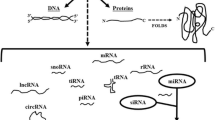Abstract
microRNAs (miRNAs) have capacity to modulate numerous biological processes and therefore synthetic oligonucleotides mimicking or inhibiting particular miRNA have potential in the development of novel types of therapeutics. We have elaborated several methods for safe and efficient overexpression of miRNAs using self-forming nanocomplexes of PepFect or NickFect type of cell-penetrating peptides (CPPs) and oligonucleotides mimicking well-characterized anti-inflammatory miR-146a. We focus on chronic inflammatory diseases affecting epithelium, such as atopic dermatitis and asthma harnessing respective cell cultures and mouse models. Here we provide protocols for miRNA transfection into primary human keratinocytes, primary human bronchial epithelial cells, and human monocyte-derived dendritic cells using CPPs PepFect14, NickFect70, NickFect71, and NickFect72. In addition, we provide protocols for application of CPP-miRNA nanocomplexes in in vivo mouse models of irritant contact dermatitis and allergic airway inflammation.
Access this chapter
Tax calculation will be finalised at checkout
Purchases are for personal use only
Similar content being viewed by others
References
Makeyev EV, Maniatis T (2008) Multilevel regulation of gene expression by microRNAs. Science 319(5871):1789–1790
Izaurralde E (2015) GENE REGULATION. Breakers and blockers-miRNAs at work. Science 349(6246):380–382
O’Connell RM, Rao DS, Baltimore D (2012) microRNA regulation of inflammatory responses. Annu Rev Immunol 30:295–312
Taganov KD et al (2006) NF-kappaB-dependent induction of microRNA miR-146, an inhibitor targeted to signaling proteins of innate immune responses. Proc Natl Acad Sci U S A 103(33):12481–12486
Kivihall A et al (2019) Reduced expression of miR-146a in human bronchial epithelial cells alters neutrophil migration. Clin Transl Allergy 9:62
Crone SG et al (2012) microRNA-146a inhibits G protein-coupled receptor-mediated activation of NF-kappaB by targeting CARD10 and COPS8 in gastric cancer. Mol Cancer 11:71
Rebane A et al (2014) MicroRNA-146a alleviates chronic skin inflammation in atopic dermatitis through suppression of innate immune responses in keratinocytes. J Allergy Clin Immunol 134(4):836–847. e11
Meisgen F et al (2014) MiR-146a negatively regulates TLR2-induced inflammatory responses in keratinocytes. J Invest Dermatol 134(7):1931–1940
Rupaimoole R, Slack FJ (2017) MicroRNA therapeutics: towards a new era for the management of cancer and other diseases. Nat Rev Drug Discov 16(3):203–222
Hu B et al (2020) Therapeutic siRNA: state of the art. Signal Transduct Target Ther 5(1):101
Janssen HL et al (2013) Treatment of HCV infection by targeting microRNA. N Engl J Med 368(18):1685–1694
Margus H, Padari K, Pooga M (2012) Cell-penetrating peptides as versatile vehicles for oligonucleotide delivery. Mol Ther 20(3):525–533
Urgard E et al (2016) Pre-administration of PepFect6-microRNA-146a nanocomplexes inhibits inflammatory responses in keratinocytes and in a mouse model of irritant contact dermatitis. J Control Release 235:195–204
Gemma Carreras-Badosa JM, Periyasamy K, Urgard E, Padari K, Vaher H, Tserel L, Gestin M, Kisand K, Arukuusk P, Lou C, Langel Ü, Wengel J, Pooga M, Rebane A (2020) NickFect type of cell-penetrating peptides present enhanced efficiency for microRNA-146a delivery into dendritic cells and during skin inflammation. Biomaterials 262:120316
Veiman KL et al (2013) PepFect14 peptide vector for efficient gene delivery in cell cultures. Mol Pharm 10(1):199–210
Ezzat K et al (2011) PepFect 14, a novel cell-penetrating peptide for oligonucleotide delivery in solution and as solid formulation. Nucleic Acids Res 39(12):5284–5298
Porosk L et al (2019) Enhancement of siRNA transfection by the optimization of fatty acid length and histidine content in the CPP. Biomater Sci 7(10):4363–4374
Basler K et al (2016) The role of tight junctions in skin barrier function and dermal absorption. J Control Release 242:105–118
Pasparakis M, Haase I, Nestle FO (2014) Mechanisms regulating skin immunity and inflammation. Nat Rev Immunol 14(5):289–301
Laanesoo A et al (2021) Dual role of the miR-146 family in rhinovirus-induced airway inflammation and allergic asthma exacerbation. Clin Transl Med. 11:e427
Vaher H et al (2019) miR-10a-5p is increased in atopic dermatitis and has capacity to inhibit keratinocyte proliferation. Allergy 74(11):2146–2156
Vaher H et al (2020) SERPINB2 and miR-146a/b are coordinately regulated and act in the suppression of psoriasis-associated inflammatory responses in keratinocytes. Exp Dermatol 29(1):51–60
Sallusto F, Lanzavecchia A (1994) Efficient presentation of soluble antigen by cultured human dendritic cells is maintained by granulocyte/macrophage colony-stimulating factor plus interleukin 4 and downregulated by tumor necrosis factor alpha. J Exp Med 179(4):1109–1118
Tibbitt CA et al (2019) Single-cell RNA sequencing of the T helper cell response to house dust mites defines a distinct gene expression signature in airway Th2 cells. Immunity 51(1):169–184
Acknowledgments
This work was supported by European Regional Development Fund (Project No. 2014-2020.4.01.15-0012) from European Union, personal (PUT1669 for AR, PUT1617 for MP) from Estonian Research Council, Leo Foundation grant (LF17040) and Institute of Technology basic financing grant (PLTTI20912 to MP).
Author information
Authors and Affiliations
Corresponding author
Editor information
Editors and Affiliations
Rights and permissions
Copyright information
© 2022 The Author(s), under exclusive license to Springer Science+Business Media, LLC, part of Springer Nature
About this protocol
Cite this protocol
Laanesoo, A., Periyasamy, K., Pooga, M., Rebane, A. (2022). Development of CPP-Based Methods for Delivery of miRNAs into the Skin and Airways: Lessons from Cell Culture and Mouse Models. In: Langel, Ü. (eds) Cell Penetrating Peptides. Methods in Molecular Biology, vol 2383. Humana, New York, NY. https://doi.org/10.1007/978-1-0716-1752-6_32
Download citation
DOI: https://doi.org/10.1007/978-1-0716-1752-6_32
Published:
Publisher Name: Humana, New York, NY
Print ISBN: 978-1-0716-1751-9
Online ISBN: 978-1-0716-1752-6
eBook Packages: Springer Protocols




